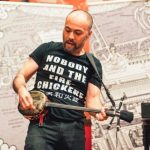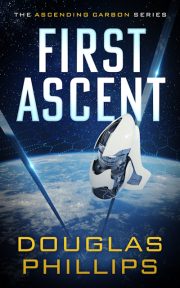Diversity Plus: Diverse Story Forms and Themes, Not Just Diverse Faces
by Henry Lien
(This article originally appeared in The SFWA Bulletin #215.)
Something I’ve noticed repeatedly in my author appearances, conference panels, and lectures is that discussions about representation and diversity in the arts today focus on the importance of diverse characters and creators. As crucial as that is, diversity can and should also include different story forms and themes drawn from diverse traditions. Values are not universal across all cultures and thus what a satisfying story looks like is not limited to one model either.
Lenses
Let’s play a game. I’m going to use a very traditional Chinese/Taiwanese lens to describe a book that is well-known here in the exotic Occident. Guess the book (answers written backwards).
Q. Majestic gold dragon is murdered by band of thieves and homeless men.
Tibboh eht
Let’s unpack that a bit. In Chinese/Taiwanese culture, the dragon is the best animal: wise, benevolent, powerful, but peaceful. Any story in which a dragon is killed is automatically a tragedy. Further, in a traditional and conservative society, thieves and the homeless are going to be viewed as failed citizens. A story where such elements triumph is going to be received as dark and wrong.
Q. Only daughter receives propitious offer of marriage from rich older man.
Thgiliwt
Okay, so I cheated a bit there, as it’s a significantly older man. But I’m making the point that vampires don’t exist in Chinese/Taiwanese lore. Thus, any downsides of vampirism in a potential son-in-law would sail right over the heads of traditional Chinese/Taiwanese parents.
The point of this game is to show a) how vastly different cultural values can be; b) how those values in turn influence what is considered a satisfying story in that culture, and c) how true diversity in the arts can and should encompass diverse story forms and themes, in addition to diverse faces.
Hamilton and Different Levels of Diversity
The discussion around Hamilton is a good case study of the different levels on which diversity can operate. In case you’re just emerging from a five-year coma and don’t know about Hamilton, it is a brilliant Tony Award and Pulitzer Prize winning musical written by Lin-Manuel Miranda about the life of American revolutionary and Founding Father Alexander Hamilton. It is notable because the musical is told almost entirely in the form of rap, hip-hop, and pop songs, and many Black and other actors of color were cast in the role of white characters, in a musical written entirely by an artist of color. The musical was praised for these elements as embracing diversity. (Note that the fact that Miranda is Latino, not Black, and any discussions around #OwnVoices and cultural appropriation are beyond the scope of this article.)
However, criticism of the musical, including from Black critics, included arguments that the musical engaged in “surface” diversity. The fact that it cast non-white actors in the roles of white characters failed to mask the fact that, out of all of the American stories from this tumultuous time that it could have told, it chose to tell a story entirely about white people. Critics argued that it fell into the “Great Men” trope that promotes the idea that great individual (usually white) men make history, instead of focusing on the many people of different backgrounds, genders, and levels of fame who make important contributions to history. Further, in many productions, the roles of George Washington and Thomas Jefferson were played by Black actors, and the irony that Black actors were playing slave owners was ignored. In short, the criticisms posited that the musical engaged in surface diversity by plopping Black and other non-white faces into a story whose substance was ultimately, wholly the story of white people. It had diverse authors and actors, but not diverse characters or subject matter.
While those criticisms are important, diversity doesn’t just encompass authors, actors, characters, or subject matter. Diversity also encompasses diverse storytelling forms. This was a play about America back then, told by America as it looks now. It was told in an idiom (rap/hip-hop/pop) that has deep Black roots. And the form in which the musical was told was integral to its personality and uniqueness. At the end of the musical, there is a song whose theme is “Who gets to tell history?” (“Who Lives, Who Dies, Who Tells Your Story?”) The song seems to anticipate the above criticisms by insisting that people of diverse backgrounds have a right to tell the story of white founding fathers, especially if they tell it in a way that is unique to their own culture.
Leslie Odom Jr., who originated the role of Aaron Burr in Hamilton, said in the New York Times that the significance of the play was related to not only “who has the mic, who is allowed to tell the story” but also to “what language the story is told in.” (Paulson, Michael, “‘Hamilton’ is Coming to the Small Screen. This Is How It Got There,” New York Times, June 25, 2020.) The actual form of the telling, rather than the character or subject matter of the story, is what makes it diverse, just as much as a Kabuki retelling of King Arthur would be diverse.
Diverse Storytelling Forms and the East Asian Four-Act Structure
The Western three-act story structure and the five-act Freytag pyramid variant are a) based on tension, conflict, and resolution; and b) symmetrical in shape (ascent, climax, descent, plus a central question posed in the first act that is answered in the last act). This story structure is currently a popular feature of stories in the West, and we consider it a staple of a nourishing and satisfying storytelling meal. However, dietary tastes are learned and transmitted, and differ culture to culture. The same is true of story tastes. And the Western three- and five-act story structures are far from the only games in town.
Take for example, the East Asian four-act structure. It is common in Chinese, Taiwanese, Korean, and Japanese storytelling, although it is most known in the West by its Japanese name kishōtenketsu.
Act One — Kiku (起句), きく — The Introduction of the Main Elements
Act Two — Shōku (承句, しょうく) — The Development of the Main Elements
Act Three — Tenku (転句, てんく) — The Twist (New Element)
Act Four — Kekku 結句, けっく) — The Conclusion (Harmonizing of All Elements)
The Asian four-act structure is not necessarily based on conflict, tension, and resolution. It is more interested in exploring the unseen relationships among the story’s elements than in pitting them against each other. It is also not symmetrical. The first two acts are characterized by a gradual buildup. A radical twist appears in the third act that introduces a new element. The fourth act “harmonizes” all the elements that came before. By “harmonize,” I don’t necessarily mean a peaceful resolution. I mean that the fourth act contains a revelation about the relationships among the elements that often feels like a new element in itself.
Parasite
On first introduction, kishōtenketsu might strike you as an alien or unsatisfying structure. However, you likely have already experienced examples of this story form without realizing it. Bong Joon-Ho’s film Parasite is a sparkling example of kishōtenketsu. In case it didn’t fly onto your radar, Parasite is a dazzling South Korean film about class struggle that swept the 2020 Oscars and became the first foreign language film to win the Best Picture Oscar. Here’s how Parasite breaks down into kishōtenketsu acts:
SPOILER ALERTS
- Act One (Ki) — Poor family struggles to make ends meet.
- Act Two (Shō) — Poor family infiltrates rich family through clever con games.
- Act Three (Ten) — Poor family discovers that there is an even poorer family living below them, socially and literally.
- Act Four (Ketsu) — Rich, poor, and even poorer family wreak revenge on the people they blame for their plight.
The element that makes kishōtenketsu so different from Western story structures, the third act twist that introduces a new element, is in fact what makes Parasitei so powerful. Western story structures would foreshadow the surprise element beginning in act one, in a more gradual progression toward the surprise element. In kishōtenketsu, there is no gradual ramp up to the surprise. Instead, there is a steep spike, which heightens the emotional shock of the surprise element.
In a traditional three-act Western story about class struggle, the critical Ten act in Parasite (act three) would probably never even have existed. It would probably have looked something like this.
- Act One — Poor family embarks on con game against rich family.
- Act Two — Con game climaxes in confrontation where truths are shared.
- Act Three — Two families realize that they have more in common with each other than they have different. High probability of the two families hugging it out before end credits roll.
Ick.
EXEUNT SPOILERS
Diverse Storytelling Themes
Let’s kick off the discussion of how cultural values impact what story themes are considered satisfying with a cautionary tale of woe. “Shakespeare in the Bush” is a famed article written by an American anthropologist who tried to explain Hamlet to a Tiv community in southeastern Nigeria. (http://www.naturalhistorymag.com/picks-from-the-past/12476/shakespeare-in-the-bush)
Idealistic American anthropologist Laura Bohannan, believing that human nature was the same the world over, tried to tell the story of Hamlet to a Tiv community in southeastern Nigeria, using Tiv words and cultural analogs. Hilarity ensued. Bohannon encountered cultural differences that radically altered the Tiv’s understanding of the story. For example, the Tiv couldn’t comprehend Hamlet’s inner turmoil at his uncle marrying his mother since it was Tiv tradition for the younger brother to marry his brother’s widow and raise his brother’s children as his own. Further, the vision that visited Hamlet couldn’t be his father’s ghost, since the Tiv didn’t know what ghosts were, and they insisted that it must be an omen sent by a witch, or if it really was Hamlet’s dead father, then it was a “zombi”. Bohannon was forced to make change after change in her telling to accommodate the Tiv’s interpretation. The story that finally limped across the finish line bore zero resemblance to “Hamlet” and satisfied no one.
Traditional Western storytelling themes center primarily on the development of the individual. That’s an epic generalization and I hate speaking in generalizations, but I’ve been doing it all throughout this article so why stop now. Western storytelling emphasizes:
- Rising self-esteem/self-empowerment arc
- Individual heroism
- Struggle against external foes
- Characters’ change
In contrast, traditional East Asian storytelling emphasizes other themes:
- The relationship of the individual to the larger group (family, society)
- Group heroism
- Internal struggle
- Characters understand (something within or outside of themselves)
Mulan
The difference between the traditional Chinese folk tale of Mulan and the Disney animated version is a clear example of both surface diversity and how different cultural values influence what story themes are considered satisfying.
In the original folk tale and poem, Mulan agrees to enlist in the army in her father’s place because he was too elderly to fight. She does this not to rebel against her family or her obligations to them, but in fact to honor them. More than half of the poem is spent describing the small details of Mulan’s domestic life before and after the excursion into the army. The actual war is glanced over in a few lines devoid of meaningful detail. Finally, the poem emphasizes that Mulan enjoys wearing her gowns and makeup and the first thing she does when she returns from the war is get done up as beautifully as possible to show the soldiers she fought with that she is a girl. The original poem sets up a non-binary notion of femininity: Mulan can both fight in a battle and wear makeup and dresses. Strong and pretty aren’t mutually exclusive.
Disney’s animated film veered wildly from these values, turning the story into a predictable Western story about rebellion against parental expectations, rejection of “female” things, physical strength, and the character “finding herself.” When the film was shown in mainland China, it belly-flopped spectacularly. The wise-cracking and anachronistic humor; the jokes that worked only in English; the typical Western empowerment character arc; the rebellion against her family; the emphasis on individual heroism; the sneering disdain for traditionally “feminine” qualities; and the aggrandizement of Mulan for single-handedly saving the empire (the Emperor and all his subjects bow to her!) all made this a film that was cosmetically Chinese, but 110% Western and contemporary in spirit. Here was an example of a story with Asian characters (and some Asian voice actors) that utterly failed to embrace its source culture in any meaningful way. It was a perfect example of surface diversity because it failed to embrace themes that would be true to its source culture.
Never Let Me Go
My final and most radical example is the novel Never Let Me Go, by Nobel Prize-winning Japanese-English author Kazuo Ishiguro, which gets my vote for “Greatest Book of the 21st Century So Far” (Time magazine agrees). The book is set in England and features a presumedly all-white cast. However, the author was born in Japan and the values explored in the book are deeply antithetical to those in typical Western narratives. For example, in the face of a harsh and repressive system, the heroic thing for our protagonist to do is not to rise up, display individual heroism, and challenge or topple the system, but to learn to quietly bear her suffering with dignity, find peace with her place in this society, and accept her powerlessness over her destiny. (!!!) The main characters come to accept their fate in sacrificing themselves for the greater societal good and any struggle they have with the unjust system is wholly internal. I’m not Japanese, but these are values that resonate with my own Taiwanese heritage. Thus, Ishiguro has done the exact reverse of what Disney’s Mulan did: create a story with no East Asian characters but that tells a profoundly East Asian story. It is the opposite of surface diversity.
Invitation
I’ve shared here just a few examples of stories finding an audience in the West that demonstrate a meaningful understanding of diverse storytelling forms and themes. I’d love to see a whole lot more. I’d invite storytellers to give themselves permission to learn more about story forms and themes informed by other traditions, in addition to including diverse characters. I’d urge readers to open their minds about what a satisfying story can look like.
Beauty comes in all shapes and sizes. The world each of us lives in can be a vast and varied place, or it can be fixed, uniform, and safe. The choice is ours.
 Henry Lien is a 2012 graduate of Clarion West. He is the author of the Peasprout Chen middle grade fantasy series. His short fiction has appeared in publications including Asimov’s, Analog, and F&SF, and he is a four-time Nebula/Norton Award finalist. Henry also teaches writing, including for the UCLA Extension Writers Program, and won the UCLA Extension Instructor of the Year award. Henry has previously worked as an attorney and fine art dealer. Born in Taiwan, Henry currently lives in Hollywood. Hobbies include writing and performing campy science fiction/fantasy anthems, and losing Nebula and Norton Awards.
Henry Lien is a 2012 graduate of Clarion West. He is the author of the Peasprout Chen middle grade fantasy series. His short fiction has appeared in publications including Asimov’s, Analog, and F&SF, and he is a four-time Nebula/Norton Award finalist. Henry also teaches writing, including for the UCLA Extension Writers Program, and won the UCLA Extension Instructor of the Year award. Henry has previously worked as an attorney and fine art dealer. Born in Taiwan, Henry currently lives in Hollywood. Hobbies include writing and performing campy science fiction/fantasy anthems, and losing Nebula and Norton Awards.


